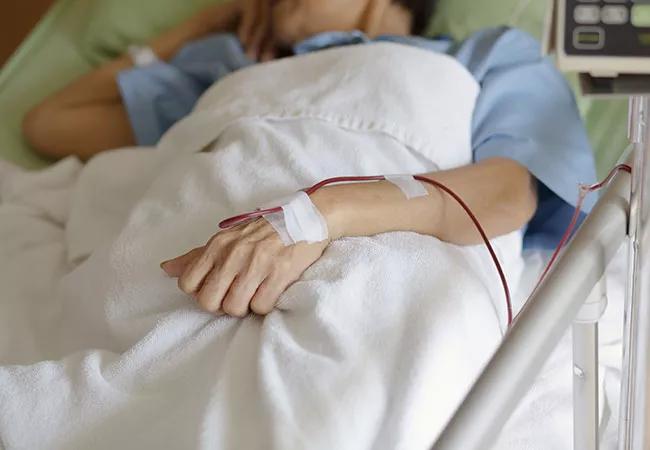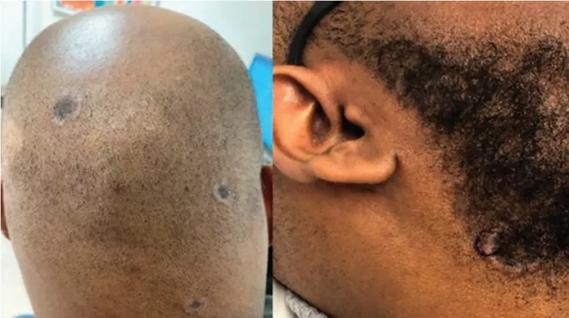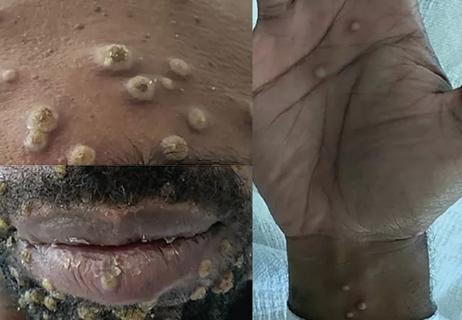Case highlights the utility of a blood substitute product when blood transfusions are not an option

Hemopure proved to be a life-saving treatment in a Cleveland Clinic patient who presented to the Emergency Department with severe hemorrhage, but refused a blood transfusion due to religious preferences.
Cleveland Clinic is a non-profit academic medical center. Advertising on our site helps support our mission. We do not endorse non-Cleveland Clinic products or services. Policy
“The patient’s presenting problem was hemorrhage from a previously unknown cervical tumor,” says Ross H. Brubaker, DO, who managed the patient during her stay in Cleveland Clinic’s Intensive Care Unit (ICU).
After the interventional radiology team embolized the arteries leading to the uterus to prevent further bleeding, Dr. Brubaker realized that the patient’s life was still in danger due to severe blood loss and low hemoglobin levels, which had dropped to 3.3 mg/dL. With the family’s permission, he administered Hemopure (Hemoglobin Oxygen Therapeutics LLC), a hemoglobin-based oxygen carrier (HBOC) solution compatible with all blood types that can serve as an alternative to blood.
“The necessity to maintain her blood pressure with medications immediately resolved with the first 250 mL of this product,” says Dr. Brubaker. “We administered a fairly small volume of the product, and, despite that small volume, her hemodynamic emergency totally resolved. Then we finished loading her with 500 mL of the product over the course of about an hour and she completely turned around. It was amazing.”
Hemopure consists of purified, glutaraldehyde-polymerized bovine hemoglobin and is stable at room temperature for three years. The product has not been approved by the U.S. Food and Drug Administration (FDA) for any indication in humans, but is available through clinical trials or via the FDA’s Expanded Access Program (EAP) for the treatment of patients with severe, life-threatening anemia for whom blood transfusion is not an option. In this case, Dr. Brubaker received approval to use the product through the EAP, also known as compassionate use approval.
The timely administration of Hemopure was possible because, fortuitously, the product was available for research purposes in the lab of Bahar Bassiri Gharb, MD, PhD. Through a timely collaboration, Hemopure was delivered to the ICU and used to immediately stabilize the patient while more was being shipped from the manufacturer. It took one hour between when Dr. Brubaker made the phone call to the company and administration to the patient. Over the next several days in the ICU, the patient received additional Hemopure for a total of seven units, after which she was transferred to a regular nursing floor where she was managed by the gynecologic oncology team until discharge.
Dr. Brubaker notes that more clinicians should be aware of the usefulness of HBOC products like Hemopure in special populations, such as those who cannot or those who refuse to receive blood products due to personal or religious reasons. He also hopes that the research on Hemopure will continue to advance and eventually lead to its approval for more widespread use.
“It’s one of those medicines that I think has a niche use, but it is unfortunately has not been approved for clinical use by FDA,” he says. “In patients who have life-threatening anemia and can’t receive red blood cells due to availability, religious or immunologic reasons, Hemopure is the only product that can temporarily take the place of blood and save these patient’s lives.”
He and his colleagues hope to present this case at the upcoming Society of Critical Care Anesthesiologists conference in an effort to increase the awareness of this very useful medication.
Dr. Bassiri Gharb and her collaborators are currently investigating the usefulness of Hemopure in ex-vivo normothermic limb perfusion (EVNLP). Her study, published in the January/February 2020 issue of Military Medicine, compared Hemopure-perfused porcine limbs to those placed in cold storage and found better preservation of the mitochondrial structure in Hemopure-perfused limbs compared to the crystallization and destruction observed in limbs in cold storage. Investigators concluded that Hemopure-EVNLP produced similar results as red blood cell-EVNLP and ensured preservation of muscle contractility and mitochondrial structure.
“Under normal circumstances, in cases of limb amputation, the limb is preserved on ice and then transported to a specialized center for replantation,” says Dr. Bassiri Gharb, who notes that in a trauma setting, the time available to perform the surgery is limited to only about 6-12 hours for large extremity segments like arms or legs. She adds that an alternative preservation technology could allow for resuscitation of the limb before replantation and a more thorough evaluation of the limb prior to transplantation, which could ensure a more successful transplant procedure.
“In any polytrauma scenario where there is blood loss and there is no immediate availability of blood products, Hemopure could be useful,” she says. “For instance, this could be a road accident.”
She says that a new clinical trial investigating the use of Hemopure in a trauma setting was set to commence in South Africa before COVID-19 hit. The trial is funded by the U.S. Department of Defense and aims to provide more information about the utility of Hemopure in the pre-hospital setting and during transport of the patient when usually blood products are not available contributing to mortality.

Consider secondary syphilis in the differential of annular lesions

Persistent rectal pain leads to diffuse pustules

Techniques are borrowed from rhinoplasty, malar augmentation and others

Two cases — both tremendously different in their level of complexity — illustrate the core principles of nasal reconstruction

Stress and immunosuppression can trigger reactivation of latent virus

Low-dose, monitored prescription therapy demonstrates success

Antioxidants, barrier-enhancing agents can improve thinning hair